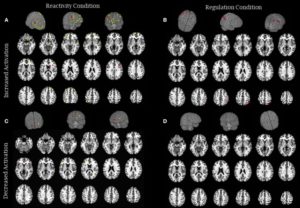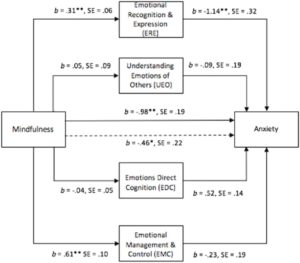Meditation Alters Brain Responses to Negative Stimuli
By John M. de Castro, Ph.D.
“meditation facilitates strengthening the Assessment Center, weakening the unhelpful aspects of the Me Center (that can cause you to take things personally), strengthening the helpful parts of the Me Center (involved with empathy and understanding others) and changing the connections to/from the bodily sensation/fear centers such that you experience sensations in a less reactive, more balanced and holistic way. In a very real way, you literally are changing your brain for the better when you meditate.” – Rebecca Gladding
There has accumulated a large amount of research demonstrating that mindfulness has significant benefits for psychological, physical, and spiritual wellbeing. It even improves high level thinking known as executive function. Its positive effects are so widespread that it is difficult to find any other treatment of any kind with such broad beneficial effects on everything from thinking to mood and happiness to severe mental and physical illnesses. This raises the question of how mindfulness training could produce such widespread and varied benefits.
Mindfulness practice has been shown to produce improved emotion regulation. Practitioners demonstrate the ability to fully sense and experience emotions, but respond to them in more appropriate and adaptive ways. In other words, mindful people are better able to experience yet control emotions. This ability of mindfulness training to improve emotion regulation may be the basis for a wide variety of benefits that mindfulness provides to mental health.
Mindfulness practices may result in beneficial changes in the nervous system that underlie emotion regulation. The nervous system is a dynamic entity, constantly changing and adapting to the environment. It will change size, activity, and connectivity in response to experience. These changes in the brain are called neuroplasticity. Over the last decade neuroscience has been studying the effects of contemplative practices on the brain and has identified neuroplastic changes in widespread areas. In other words, mindfulness practice appears to mold and change the brain, producing psychological, physical, and spiritual benefits.
In today’s Research News article “Does Meditation Alter Brain Responses to Negative Stimuli? A Systematic Review.” (See summary below or view the full text of the study at: https://www.ncbi.nlm.nih.gov/pmc/articles/PMC6243128/ ), Magalhaes and colleagues review and summarize the published research literature on the ability of mindful practice to alter brain responses to improve the regulation of emotions especially reactions to negative events.
They identified 11 published studies that used functional Magnetic Resonance Imaging (fMRI) to assess brain responses to negative stimuli before and after mindfulness training. Six of these studies involved a comparison to a control group while five involved before after comparisons. They found that the research, in general, indicated that mindfulness training resulted in greater activation of the frontal and prefrontal cortical regions of the brain in response to negative emotion eliciting stimuli. A number of studies also identified greater activation of the insular cortical region.
These are interesting findings as the frontal and prefrontal cortical regions have been identified as involved in higher level thought processes and particularly attentional processes. This suggests that a top down, cognitive, regulation of emotion is elicited to negative stimuli. Hence, it appears that individuals, trained in mindfulness, deal with negative emotions with attention and reason, analyzing the reality of the situation, and thereby responding less intensely and more adaptively and appropriately.
The insular region has been shown to be involved in body sense, particularly interoceptive awareness of the state of the body. Its heightened response to negative stimuli after mindfulness training suggests that trained individuals have a heightened sense of how their bodies are responding to a negative emotion. Many people are unaware of their physiological reactions to emotions. By improving this internal awareness mindfulness training may make individuals better able to detect when a emotion is arising and thereby better able to regulate it.
Hence, the published research indicates that mindfulness training results in changes to the brain that improve the detection of emotional reactions and the ability to attend to and rationally process the conditions that elicited them. These neuroplastic changes to the brain may underlie the ability of mindfulness training to enhance emotion regulation in response to negative situations and thereby improve the mental health of practitioners.
“Now, as the popularity of mindfulness grows, brain imaging techniques are revealing that this ancient practice can profoundly change the way different regions of the brain communicate with each other – and therefore how we think – permanently.” – Tom Ireland
CMCS – Center for Mindfulness and Contemplative Studies
This and other Contemplative Studies posts are also available on Google+ https://plus.google.com/106784388191201299496/posts and on Twitter @MindfulResearch
Study Summary
Magalhaes, A. A., Oliveira, L., Pereira, M. G., & Menezes, C. B. (2018). Does Meditation Alter Brain Responses to Negative Stimuli? A Systematic Review. Frontiers in human neuroscience, 12, 448. doi:10.3389/fnhum.2018.00448
Abstract
Background: Despite several attempts to review and explain how meditation alters the brain and facilitates emotion regulation, the extent to which meditation and emotion regulation strategies share the same neural mechanisms remains unclear.
Objective: We aim to understand the influence of meditation on the neural processing of negative emotional stimuli in participants who underwent meditation interventions (naive meditators) and long-term meditators.
Methodology: A systematic review was conducted using standardized search operators that included the presence of terms related to emotion, meditation and neuro-imaging techniques in PsycInfo, PubMed, Scopus, and Web of Science databases.
Results: Searches identified 882 papers, of which 11 were eligible for inclusion. Results showed a predominance of greater prefrontal/frontal activity related to meditation, which might indicate the increased recruitment of cognitive/attentional control resources in naïve and long-term meditators. This increased frontal activity was also observed when participants were asked to simply react to negative stimuli. Findings from emotion-related areas were scarce but suggested increased insular activity in meditators, potentially indicating that meditation might be associated with greater bodily awareness.
Conclusions: Meditation practice prompts regulatory mechanisms when participants face aversive stimuli, even without an explicit request. Moreover, some studies reported increased insular activity in meditators, consistent with the hypothesis that meditation helps foster an interoceptive awareness of bodily and emotional states.
https://www.ncbi.nlm.nih.gov/pmc/articles/PMC6243128/









